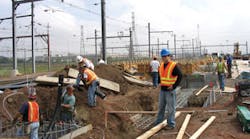From the break of dawn to the twilight hours, trains click and clack along the track from New Jersey to the Big Apple. This rail fleet is cleaned, maintained, and repaired at Meadows Maintenance Complex, located about five miles outside New York City in Kearny, N.J.
To meet the increased demand for service into New York and extend service into outlying areas, the transit department is expanding the capacity of the maintenance facility to handle 300 additional passenger cars. The existing 500,000-square-foot facility services more than 800 locomotives and passenger cars each year.
The New Jersey Transit Authority launched the $68 million expansion project in September 2003. It hired E.E. Cruz and Co., a Homedale, N.J.-based general contracting firm, to add on to the three 20-year-old masonry block and steel buildings and construct a bi-directional train wash facility, a mechanical support building, and two facilities for cleaning and servicing the locomotives.
“This is the main service facility for the trains, which run throughout most of the state,” says Ray Optof, project manager for Kevco Electric, a Middlesex, N.J.-based electrical contracting firm that won the $8 million contract to install lighting fixtures and supply power to the complex. “Over time, there's been a continued growth in the number of passengers that New Jersey has on its overall system. Rather than driving into New York City, more people are starting to take the train so they don't have to worry about the heightened security and where to park when they get there.”
Kevco is responsible for installing duct banks and 5kV feeders, providing temporary power to the trailer complexes, and installing weatherproof lighting fixtures to illuminate the service pits and the areas above and below the track level. To upgrade and better balance the electrical system in the three existing buildings, Kevco plans to tap into the main service, upgrade the breakers, and redistribute some of the loads.
Because the facility is in operation 24 hours a day, the crew faces the danger of working in an active rail yard. Kevco requires its electricians to attend a special safety training course as well as weekly safety meetings. When the electricians are working in an area close to the track, Kevco requires flagmen to be stationed nearby to add an extra level of protection. Electricians are also advised to look both ways before crossing the tracks and be on their guard in the active areas with blind spots.
“Trains are constantly moving in and out of here,” Optof says. “Believe it or not, they can be quiet and can sneak up on you if you're not careful. Because part of the work involves construction in the yards, we're constantly crossing tracks with either personnel or with vehicles.”
Robert Stepien, project manager for E.E. Cruz and Co., says in addition to dealing with the challenge of working near the tracks, the construction team must also carefully coordinate power and utility shutdowns with the operating facility. If the workers need to dig underneath the railroad tracks, they have no more than eight hours to put the track back in service.
The construction team expects to complete the job by May 2006. Because of the dire need for more space at the facility, the crew is faced with a compressed construction schedule, Optof says.
“When they first identified a need for expanding the facility, they were able to handle the increased volume, but by the time the actual drawings were done and the job was bid, they reached the point where they were already beyond capacity,” he says. “Our challenge is to try not to impact their ability to maintain their present operation.”
Sidebar: Electrical Needs by the Numbers
- 27 different types of lighting fixtures, including high bay, high mast, and catenary site lighting
- 61 catenary structures
- 8,000 feet of lead sheath triplex 750 kcmil cable
- 20 electricians at peak time




